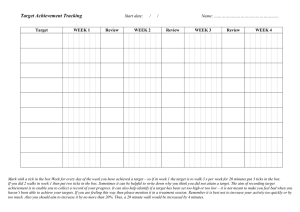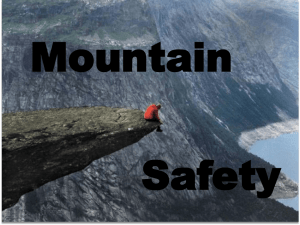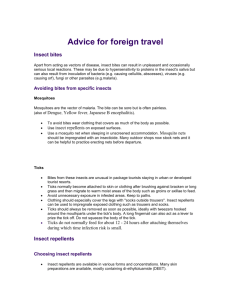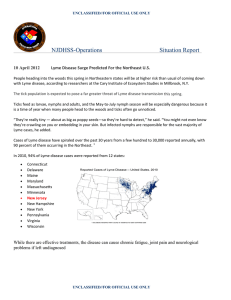More Than Just a Nuisance… Biting Insects Can Impact Health and
advertisement
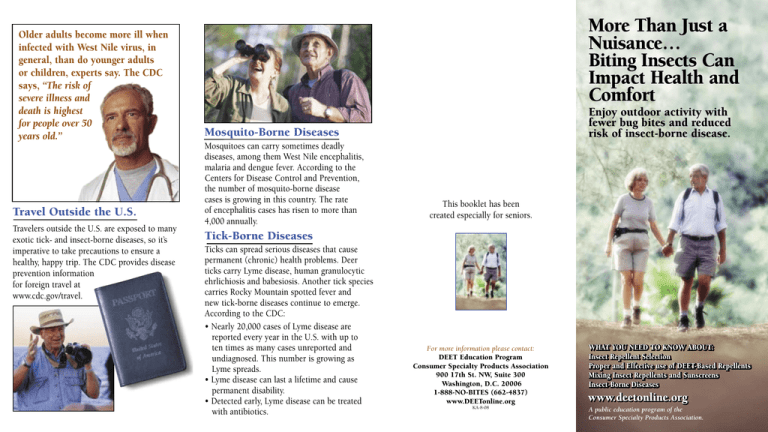
Older adults become more ill when infected with West Nile virus, in general, than do younger adults or children, experts say. The CDC says, “The risk of severe illness and death is highest for people over 50 years old.” Travel Outside the U.S. Travelers outside the U.S. are exposed to many exotic tick- and insect-borne diseases, so it’s imperative to take precautions to ensure a healthy, happy trip. The CDC provides disease prevention information for foreign travel at www.cdc.gov/travel. More Than Just a Nuisance… Biting Insects Can Impact Health and Comfort Enjoy outdoor activity with fewer bug bites and reduced risk of insect-borne disease. Mosquito-Borne Diseases Mosquitoes can carry sometimes deadly diseases, among them West Nile encephalitis, malaria and dengue fever. According to the Centers for Disease Control and Prevention, the number of mosquito-borne disease cases is growing in this country. The rate of encephalitis cases has risen to more than 4,000 annually. This booklet has been created especially for seniors. Tick-Borne Diseases Ticks can spread serious diseases that cause permanent (chronic) health problems. Deer ticks carry Lyme disease, human granulocytic ehrlichiosis and babesiosis. Another tick species carries Rocky Mountain spotted fever and new tick-borne diseases continue to emerge. According to the CDC: • Nearly 20,000 cases of Lyme disease are reported every year in the U.S. with up to ten times as many cases unreported and undiagnosed. This number is growing as Lyme spreads. • Lyme disease can last a lifetime and cause permanent disability. • Detected early, Lyme disease can be treated with antibiotics. For more information please contact: DEET Education Program Consumer Specialty Products Association 900 17th St. NW, Suite 300 Washington, D.C. 20006 1-888-NO-BITES (662-4837) www.DEETonline.org KA-8-08 WHAT YOU NEED TO KNOW ABOUT: Insect Repellent Selection Proper and Effective use of DEET-Based Repellents Mixing Insect Repellents and Sunscreens Insect-Borne Diseases www.deetonline.org A public education program of the Consumer Specialty Products Association. Insects Are Everywhere Experts suggest the following steps to help reduce exposure to insect bites and the diseases insects may carry: • Use a DEET-based insect repellent, as recommended by the Centers for Disease Control and Prevention. These products are the most effective. • Follow all label directions. • Dress in light-colored clothes to discourage mosquitoes and to enable you to spot ticks more easily. Wear collared, long-sleeved shirts and long pants with cuffs.Tuck your shirt into your pants and the pant cuffs into your socks or boots for maximum protection from ticks. • Avoid heavily wooded, high-grass areas and standing water. • Look for ticks before you return indoors. Some are only the size of a pinhead. Check your clothing and around the scalp, nape of the neck, behind ears and knees, and armpits. • Remove ticks completely with tweezers. DO NOT remove ticks with petroleum jelly, hot objects such as matches, or by other methods that can increase the chance of the tick’s injecting you with bacteria. Flush any live ticks down a drain. Dead ticks can go into household trash. • If bitten by any insect or tick, treat insect and tick bites with a topical antibiotic. If rashes or flu-like symptoms occur, seek medical attention immediately. West Nile encephalitis, Lyme disease, Rocky Mountain spotted fever and other diseases occur across the U.S., with the number of reported cases growing annually. Much more than just annoying, bites from infected mosquitoes and ticks can inject parasites and viruses into your body. Frequently Asked Questions Q. What is DEET? A. DEET (N, N-diethyl-m-toluamide) is the active ingredient in most insect repellents applied to the skin. DEET was developed more than 50 years ago by the U.S. Department of Agriculture for military use and was registered for the general public in 1957. Approximately 30 percent of Americans use DEET repellents each year. Q. Does DEET have government approval? A. DEET is registered by the Environmental Protrection Agency for use according to label instructions. Registration occurs only after determining that products meet the strictest standards for effectiveness and after assessing risks to human health and to the environment. Q. Which DEET concentration should I use? A. Generally, the longer you are outside, the higher concentration you should use. Higher concentrations also are recommended for all outdoor activities in regions with large populations of biting insects or ticks. Other factors are the type of activity and geographic location. The EPA has determined that, when label instructions are followed, all concentrations can be used by individuals of all ages. Use at least a 15% concentration for protection from ticks. Q. Can I use a DEET-based insect repellent and sunscreen together? A. The use of separate sunscreen and repellent may reduce the effectiveness of either or both the sunscreen and repellent. Combination repellent/sunscreen products help avoid this problem and ensure that the products effectively deliver both benefits (UV protection and insect repellency). Keep in mind that the duration of UV protection is quite variable among individuals, so UV protection may or may not last as long as the repellent will. Despite this, combination products should be used primarily as repellents and reapplied only when needed for insect protection. What’s the best way to apply DEET-based insect repellents? Do • Apply to exposed skin as directed on the product label. Aerosols or pump sprays provide even application. • Use liquids, creams, lotions or sticks to apply more precisely to exposed skin. • After your outdoor activity, wash repellenttreated skin with soap and water. Always keep insect repellents out of the reach of small children. Don’t • Don’t apply to eyes or lips or over cuts, wounds or irritated skin. • Don’t overapply or saturate skin or clothing. • Don’t apply to skin underneath clothing. • Don’t apply more frequently than directed on the product label.
